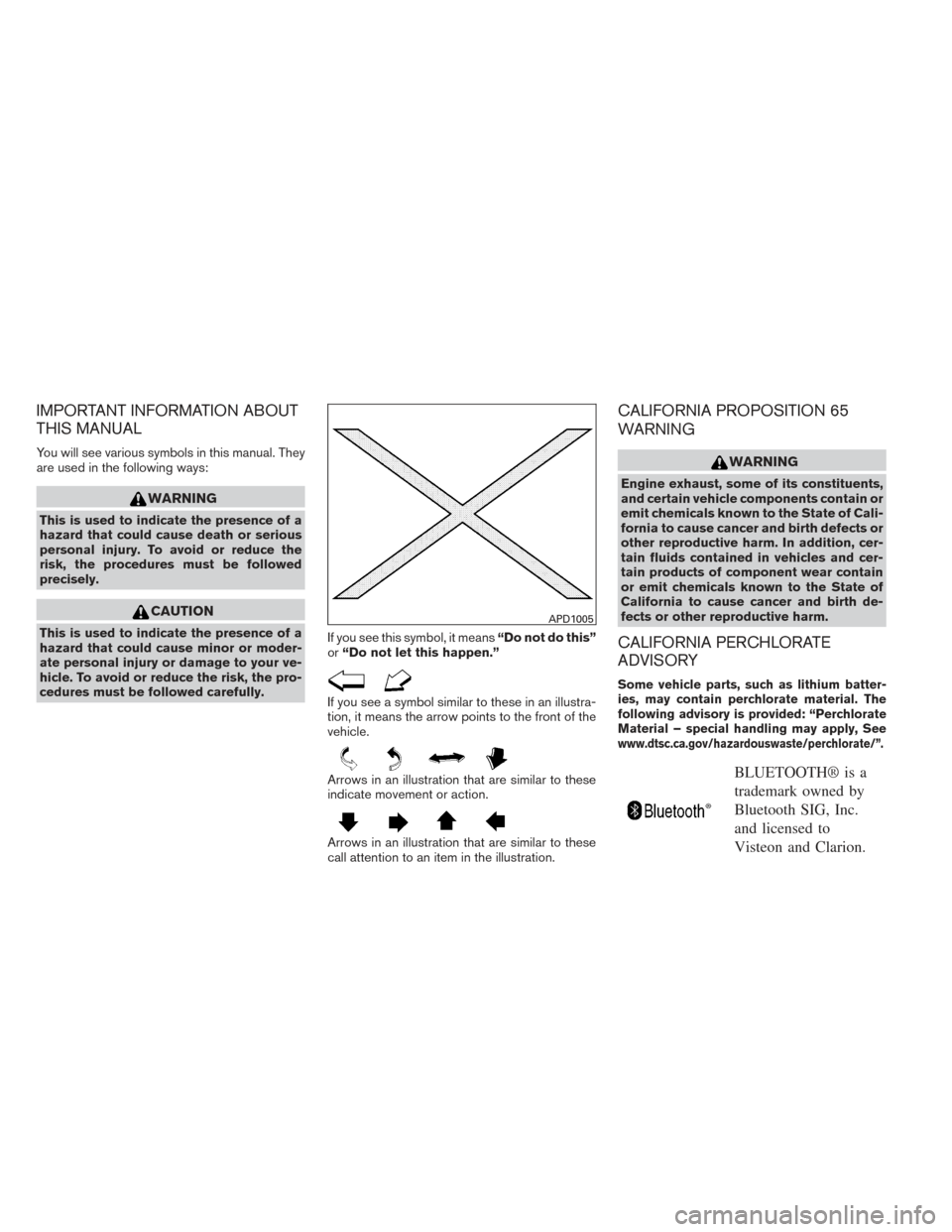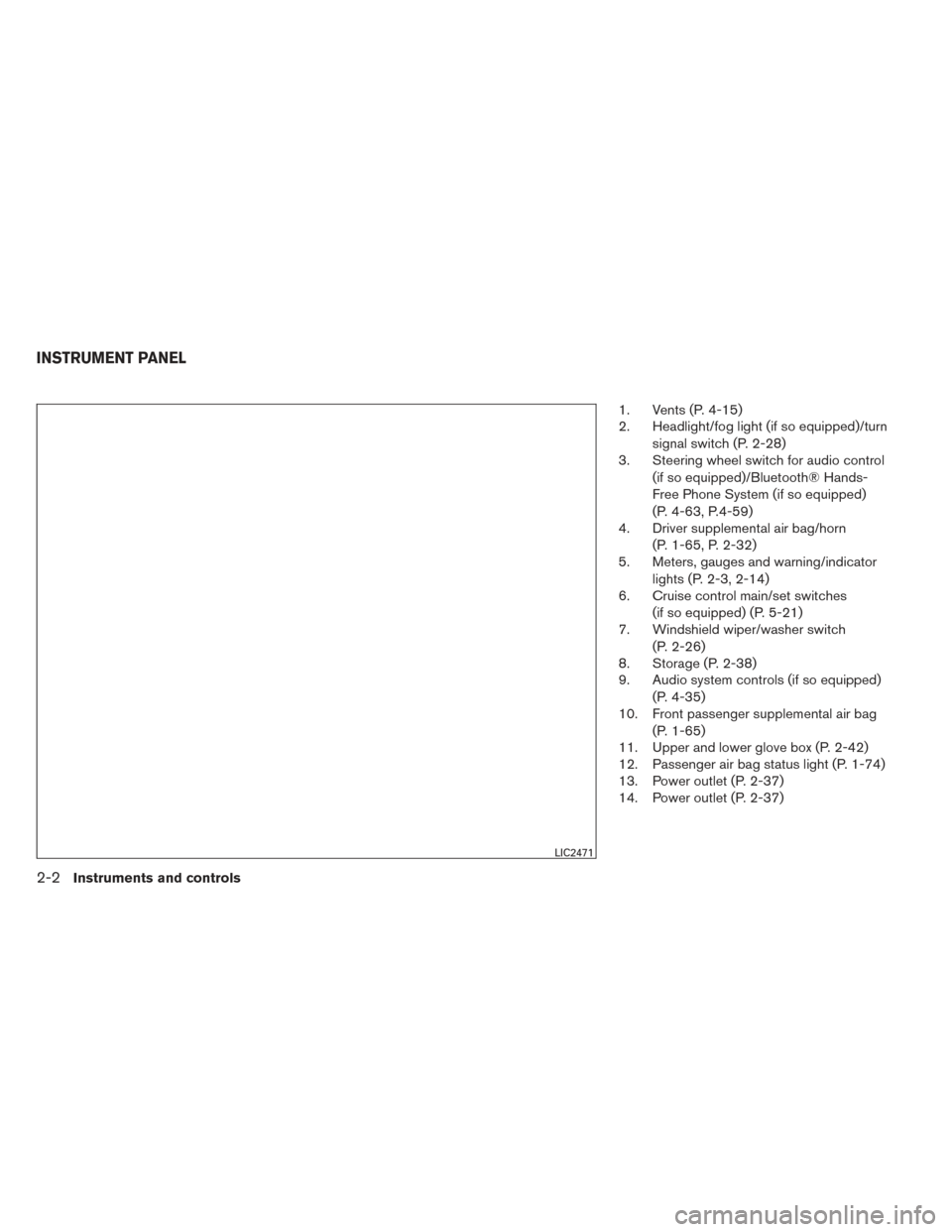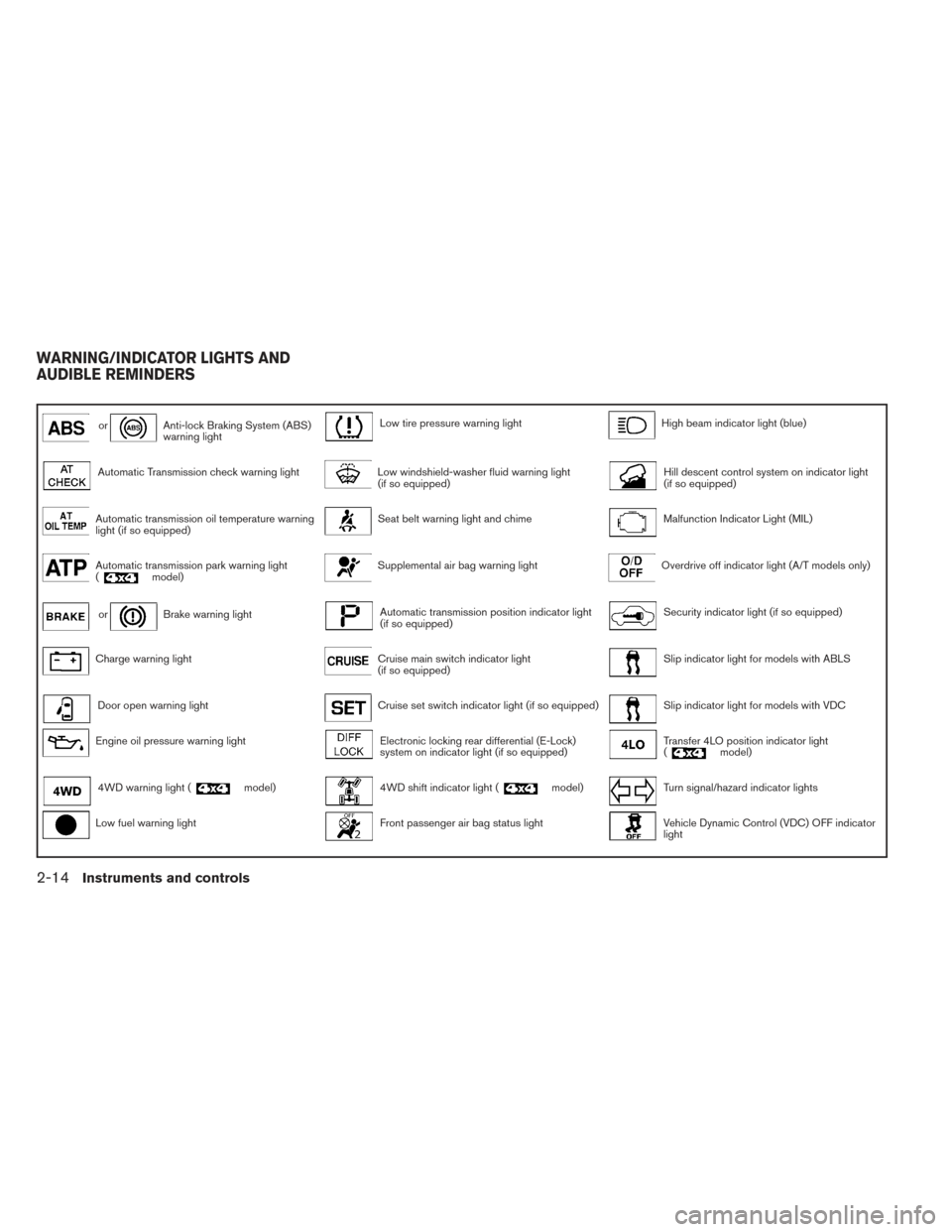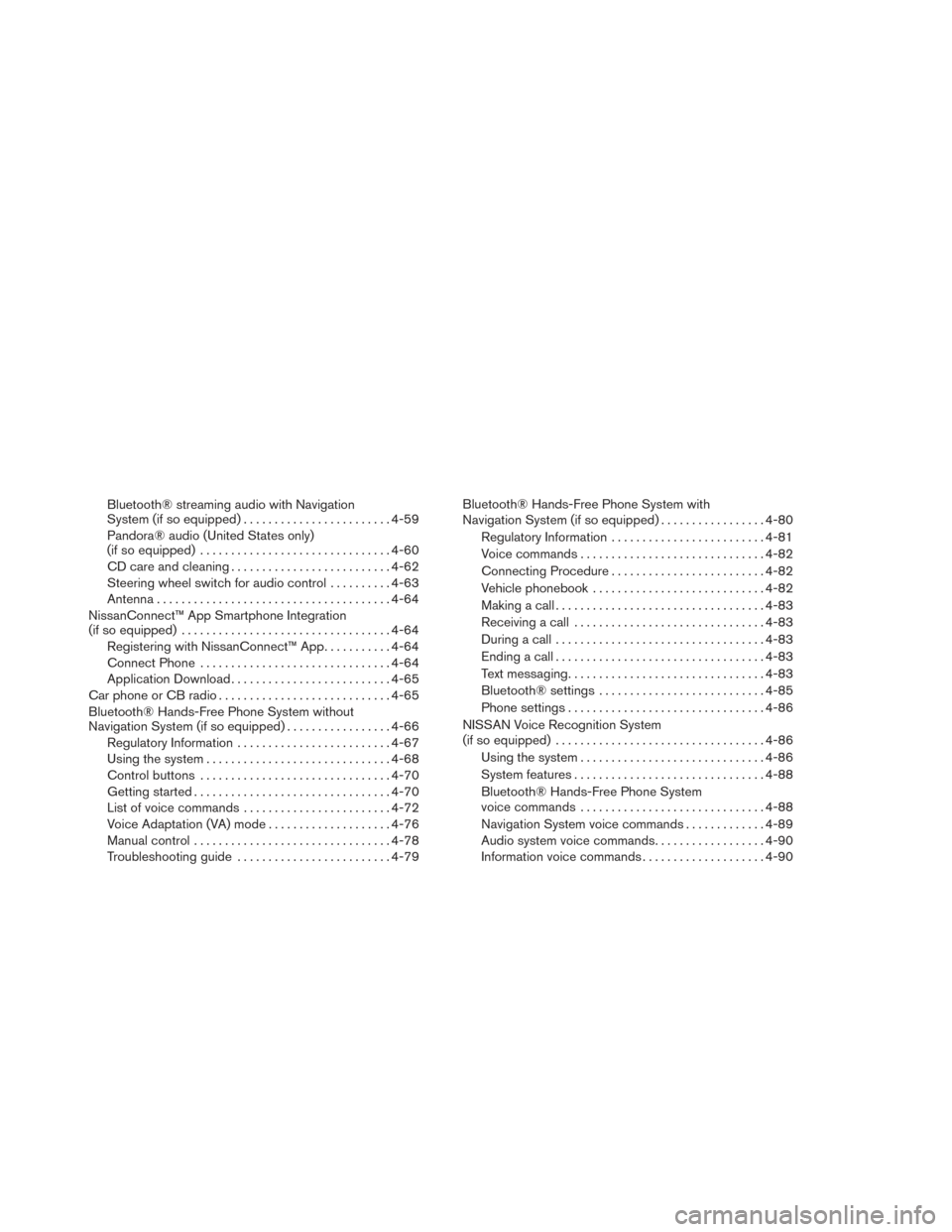2014 NISSAN FRONTIER ad blue
[x] Cancel search: ad bluePage 4 of 434

IMPORTANT INFORMATION ABOUT
THIS MANUAL
You will see various symbols in this manual. They
are used in the following ways:
WARNING
This is used to indicate the presence of a
hazard that could cause death or serious
personal injury. To avoid or reduce the
risk, the procedures must be followed
precisely.
CAUTION
This is used to indicate the presence of a
hazard that could cause minor or moder-
ate personal injury or damage to your ve-
hicle. To avoid or reduce the risk, the pro-
cedures must be followed carefully.If you see this symbol, it means
“Do not do this”
or “Do not let this happen.”
If you see a symbol similar to these in an illustra-
tion, it means the arrow points to the front of the
vehicle.
Arrows in an illustration that are similar to these
indicate movement or action.
Arrows in an illustration that are similar to these
call attention to an item in the illustration.
CALIFORNIA PROPOSITION 65
WARNING
WARNING
Engine exhaust, some of its constituents,
and certain vehicle components contain or
emit chemicals known to the State of Cali-
fornia to cause cancer and birth defects or
other reproductive harm. In addition, cer-
tain fluids contained in vehicles and cer-
tain products of component wear contain
or emit chemicals known to the State of
California to cause cancer and birth de-
fects or other reproductive harm.
CALIFORNIA PERCHLORATE
ADVISORY
Some vehicle parts, such as lithium batter-
ies, may contain perchlorate material. The
following advisory is provided: “Perchlorate
Material – special handling may apply, See
www.dtsc.ca.gov/hazardouswaste/perchlorate/”.
BLUETOOTH® is a
trademark owned by
Bluetooth SIG, Inc.
and licensed to
Visteon and Clarion.
APD1005
Page 15 of 434

1. Vents (P. 4-15)
2. Headlight/fog light (if so equipped)/turnsignal switch (P. 2-28)
3. Steering wheel switch for audio control
(if so equipped)/Bluetooth® Hands-
Free Phone System (if so equipped)
(P. 4-63, P.4-59)
4. Driver supplemental air bag/horn
(P. 1-65, P. 2-32)
5. Meters, gauges and warning/indicator
lights (P. 2-3, 2-14)
6. Cruise control main/set switches
(if so equipped) (P. 5-21)
7. Windshield wiper/washer switch
(P. 2-26)
8. Storage (P. 2-38)
9. Audio system controls (if so equipped)
(P. 4-35)
10. Front passenger supplemental air bag
(P. 1-65)
11. Upper and lower glove box (P. 2-42)
12. Passenger air bag status light (P. 1-74)
13. Power outlet (P. 2-37)
14. Power outlet (P. 2-37)
LIC2471
INSTRUMENT PANEL
0-6Illustrated table of contents
Page 20 of 434

Indicatorlight Name Page
4WD shift indicator
light (
model) 2-20
Front passenger air
bag status light
2-20
High beam indicator
light (blue)2-21
Hill descent control
system on indicator
light (if so equipped)2-34
Malfunction Indica-
tor Light (MIL)
2-21
Overdrive off indica-
tor light (A/T models
only)2-22
Security indicator
light (if so equipped)
2-22
Indicator
light Name Page
Slip indicator light
for models with
ABLS 2-22
Slip indicator light
for models with
VDC2-22
Transfer 4LO posi-
tion indicator light
(
model)2-22
Turn signal/hazard
indicator lights
2-23
Vehicle Dynamic
Control (VDC) OFF
indicator light2-23
Illustrated table of contents0-11
Page 105 of 434

1. Vents (P. 4-15)
2. Headlight/fog light (if so equipped)/turnsignal switch (P. 2-28)
3. Steering wheel switch for audio control
(if so equipped)/Bluetooth® Hands-
Free Phone System (if so equipped)
(P. 4-63, P.4-59)
4. Driver supplemental air bag/horn
(P. 1-65, P. 2-32)
5. Meters, gauges and warning/indicator
lights (P. 2-3, 2-14)
6. Cruise control main/set switches
(if so equipped) (P. 5-21)
7. Windshield wiper/washer switch
(P. 2-26)
8. Storage (P. 2-38)
9. Audio system controls (if so equipped)
(P. 4-35)
10. Front passenger supplemental air bag
(P. 1-65)
11. Upper and lower glove box (P. 2-42)
12. Passenger air bag status light (P. 1-74)
13. Power outlet (P. 2-37)
14. Power outlet (P. 2-37)
LIC2471
INSTRUMENT PANEL
2-2Instruments and controls
Page 117 of 434

orAnti-lock Braking System (ABS)
warning lightLow tire pressure warning lightHigh beam indicator light (blue)
Automatic Transmission check warning lightLow windshield-washer fluid warning light
(if so equipped)Hill descent control system on indicator light
(if so equipped)
Automatic transmission oil temperature warning
light (if so equipped)Seat belt warning light and chimeMalfunction Indicator Light (MIL)
Automatic transmission park warning light
(model)Supplemental air bag warning lightOverdrive off indicator light (A/T models only)
orBrake warning lightAutomatic transmission position indicator light
(if so equipped)Security indicator light (if so equipped)
Charge warning lightCruise main switch indicator light
(if so equipped)Slip indicator light for models with ABLS
Door open warning lightCruise set switch indicator light (if so equipped)Slip indicator light for models with VDC
Engine oil pressure warning lightElectronic locking rear differential (E-Lock)
system on indicator light (if so equipped)Transfer 4LO position indicator light
(model)
4WD warning light (model)4WD shift indicator light (model)Turn signal/hazard indicator lights
Low fuel warning lightFront passenger air bag status lightVehicle Dynamic Control (VDC) OFF indicator
light
WARNING/INDICATOR LIGHTS AND
AUDIBLE REMINDERS
2-14Instruments and controls
Page 124 of 434

High beam indicator light(blue)
This blue light comes on when the headlight high
beams are on and goes out when the low beams
are selected.
The high beam indicator light also comes on
when the passing signal is activated.
Hill descent control system onindicator light (if so equipped)
When the ignition switch is placed in the ON
position, this light comes on briefly and then turns
off.
The light comes on when the hill descent control
system is activated.
If the hill descent control switch is on and the
indicator light blinks, the system is not engaged.
If the indicator light does not come on when the
hill descent switch is on, the system may not be
functioning properly. Have the system checked
by a NISSAN dealer.
For additional information, see “Hill descent con-
trol switch” later in this section and “Hill descent
control system” in the “Starting and driving” sec-
tion of this manual.
Malfunction Indicator Light(MIL)
If this indicator light comes on steady or blinks
while the engine is running, it may indicate a
potential emission control malfunction.
The Malfunction Indicator Light may also come
on steady if the fuel-filler cap is loose or missing,
or if the vehicle runs out of fuel. Check to make
sure the fuel-filler cap is installed and closed
tightly, and that the vehicle has at least 3 gal
(11.4 L) of fuel in the fuel tank.
After a few driving trips, the
light should
turn off if no other potential emission control
system malfunction exists.
If this indicator light comes on steady for 20 sec-
onds and then blinks for 10 seconds when the
engine is not running, it indicates that the vehicle
is not ready for an emission control system
inspection/maintenance test. See “Readiness for
inspection/maintenance (I/M) test” in the “Tech-
nical and consumer information” section of this
manual. Operation
The Malfunction Indicator Light will come on in
one of two ways:
● Malfunction Indicator Light on steady — An
emission control system malfunction has
been detected. Check the fuel-filler cap if
the LOOSE FUEL CAP warning message is
displayed in the odometer. If the fuel-filler
cap is loose or missing, tighten or install the
cap and continue to drive the vehicle.
The
light should turn off after a few
driving trips. If the
light does not turn
off after a few driving trips, have the vehicle
inspected by a NISSAN dealer. You do not
need to have your vehicle towed to the
dealer.
● Malfunction Indicator Light blinking — An
engine misfire has been detected which may
damage the emission control system. To re-
duce or avoid emission control system dam-
age:
– do not drive at speeds above 45 MPH (72 km/h).
– avoid hard acceleration or deceleration.
– avoid steep uphill grades.
– if possible, reduce the amount of cargo being hauled or towed.
Instruments and controls2-21
Page 185 of 434

Bluetooth® streaming audio with Navigation
System (if so equipped)........................ 4-59
Pandora® audio (United States only)
(if so equipped) ............................... 4-60
CD care and cleaning .......................... 4-62
Steering wheel switch for audio control ..........4-63
Antenna ...................................... 4-64
NissanConnect™ App Smartphone Integration
(if so equipped) .................................. 4-64
Registering with NissanConnect™ App ...........4-64
Connect Phone ............................... 4-64
Application Download .......................... 4-65
Car phone or CB radio . . .......................... 4-65
Bluetooth® Hands-Free Phone System without
Navigation System (if so equipped) .................4-66
Regulatory Information ......................... 4-67
Using the system .............................. 4-68
Control buttons ............................... 4-70
Getting started ................................ 4-70
List of voice commands ........................ 4-72
Voice Adaptation (VA) mode ....................4-76
Manual control ................................ 4-78
Troubleshooting guide ......................... 4-79Bluetooth® Hands-Free Phone System with
Navigation System (if so equipped)
.................4-80
Regulatory Information ......................... 4-81
Voice commands .............................. 4-82
Connecting Procedure ......................... 4-82
Vehicle phonebook ............................ 4-82
Making a call .................................. 4-83
Receiving a call ............................... 4-83
During a call .................................. 4-83
Ending a call .................................. 4-83
Text messaging ................................ 4-83
Bluetooth® settings ........................... 4-85
Phone settings ................................ 4-86
NISSAN Voice Recognition System
(if so equipped) . . . ............................... 4-86
Using
the system .............................. 4-86
System features ............................... 4-88
Bluetooth® Hands-Free Phone System
voice commands .............................. 4-88
Navigation System voice commands .............4-89
Audio system voice commands ..................4-90
Information voice commands ....................4-90
Page 188 of 434

* For information regarding the Navigation system
control buttons, refer to the separate Navigation
System Owner’s Manual.
** For information regarding the Bluetooth®
Hands-Free Phone System control button, see
“Bluetooth® Hands-Free Phone System with
navigation system” or “Bluetooth® Hands-Free
Phone System without navigation system” in this
section.
When you use this system, make sure the engine
is running.
If you use the system with the engine not
running (ignition ON or ACC) for a long
time, it will discharge the battery, and the
engine will not start.
Reference symbols:
“Example” — Words marked in quotes refer to a
key shown only on the display. These keys can be
selected by touching the screen.HOW TO USE THE TOUCH
SCREEN
CAUTION
●The glass display screen may break if it
is hit with a hard or sharp object. If the
glass screen breaks, do not touch it.
Doing so could result in an injury.
● To clean the display, never use a rough
cloth, alcohol, benzine, thinner or any
kind of solvent or paper towel with a
chemical cleaning agent. They will
scratch or deteriorate the panel.
● Do not splash any liquid such as water
or car fragrance on the display. Contact
with liquid will cause the system to
malfunction.
To help ensure safe driving, some functions can-
not be operated while driving.
The on-screen functions that are not available
while driving will be “grayed out” or muted.
Park the vehicle in a safe location and then oper-
ate the navigation system.
WARNING
● ALWAYS give your full attention to
driving.
● Avoid using vehicle features that could
distract you. If distracted, you could
lose control of your vehicle and cause
an accident.
Monitor, climate, audio, phone and voice recognition systems4-5